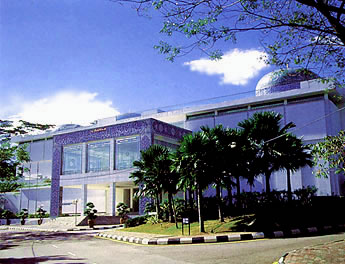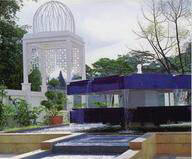Islamic Arts Museum ~ Places to Visit
in Kuala Lumpur
KL Visitors Guide
HOME >
VISITORS
GUIDE >
PLACES TO
VISIT >
KL LAKE GARDENS AREA > ISLAMIC ARTS
MUSEUM
Carved into a hillside and surrounded by lush greenery, The Islamic Arts
Museum Malaysia (IAMM), the largest of
its kind in South East Asia.

The Islamic Arts Museum
houses more than seven thousand displays of old calligraphic scrolls,
fine porcelain, impressive textiles, jewel-encrusted swords and weaponry as
well as local and international
Islamic oriented exhibitions.
Opened in December 1998, this
four-storey building located on a plateau of sloping terrain, imparts
modernity and subtle Islamic through details such as the tile
work in Mo'arraq style and Kufi and Tuluth calligraphy covering the
turquoise domes surfaces.
 The Museum's
facade is clad primarily with white marble and curved panels with features
crafted by the artisans from Uzbekistan and Iran.
The Museum's
facade is clad primarily with white marble and curved panels with features
crafted by the artisans from Uzbekistan and Iran.
The main entrance is
identified by the 'blue iwan', which is finished with cut blue tiles and a
welcoming verse from the Quran.
Its white interiors are
silent, airy and saturated with natural light, creating an atmosphere for
contemplation and reflection of thoughts.
The main lobby overlooks the
courtyard, several fountains, a restaurant, and a cafι.
 The
Islamic Arts Museum has two floors of permanent galleries, and two special
galleries for temporary exhibitions. The permanent galleries spread over
level 3 and 4, has 12 main sections classified according to the types of
artefacts.
The
Islamic Arts Museum has two floors of permanent galleries, and two special
galleries for temporary exhibitions. The permanent galleries spread over
level 3 and 4, has 12 main sections classified according to the types of
artefacts.
Located on level 3 are the
exceptions; the India Gallery, China Gallery and Malay World Gallery. The
aim is to create a collection that is truly representative of the Islamic
world.
Rather than just concentrating
on works from the heartlands of Persia and the Middle East, it also puts the
emphasis on Asia, especially Southeast Asia, China and India. These three
galleries serve as representations of the diversity of Islamic peoples and
the multi-cultural heritage of Malaysia.

Also located on level 3 are the Architecture Gallery, the Qurans &
Manuscripts Gallery and the Ottoman Room - a reconstructed interior of an
Ottoman Syrian room dated 1820 - 1821 AD.
The room comprises of
authentic floor tiles; intricately carved, lacquered wooden panels and
chandeliers.
On level 4, the Ceramics &
Glass Gallery, Metalwork Gallery, Woodwork Gallery, Arms & Armour Gallery,
Jewellery Gallery, and Textiles Gallery; exhibits collections displayed
thematically, according to chronology, region or technique of production.
LEVEL 3
Galleries: India / China / Malay World / Architecture / Qurans & Manuscripts
Ottoman Room

Architecture
Conveying the splendour of this monumental art form is a comprehensive
collection of scale models. These range from the colossal grandeur of the
holiest mosque in Islam Meccas Masjid al-Haram to the more desolate
beauty of Central Asian mausoleums dedicated to Timur and Amir Albukhari.
Every corner of Islam is covered in miniature, including the widely
overlooked mosques of China and Southeast Asia. To give a more intimate
impression of these sacred spaces, the gallery includes a re-creation of a
mosque interior.
India
Gallery provides a glimpse into the two worlds of the Mughals: public and
private. There are many features of Mughal art that diverge from the Islamic
mainstream. The most obvious of these is a delight in portraiture. Court
life demanded an impressive array of vessels and other types of tableware.
Rather than being made from ceramic, they tended to be masterpieces of the
metalworkers art.
China
The most distinctive works are calligraphic scrolls that take a traditional,
Chinese approach. The written word is found in many other Chinese Islamic
media. These include the cloisonnι wares that China started to create in
quantity during the 15th century. The rich colours of the enamels make a
vivid contrast to plain calligraphic belief. The same blending of cultures
is evident in bronze altar vessels, originally made for traditional worship
and then adapted to suit the tastes of Muslim patrons.
Malay World
Natural forms in Islamic art of Southeast Asia are conveyed as stylised
plants, fruits and clouds in a wide variety of media. On textiles, these are
often taken to a degree of abstraction that puts them in the realm of pure
geometry. Craftsmanship in wood and metal, especially the creation of 'kris'
daggers, is another tradition for which the Malay world was renowned.
Quran & Manuscripts
A large collection of Qurans, religious and secular texts from a range of
provenances; namely Persia, China, India, Turkey and the Malay World are
highlighted. This gallery serves to illustrate the different styles of
calligraphic scripts and to provide visual examples of elaborate
illumination of the Quran. The secular texts include examples of Persian
marriage certificates, miniature paintings, texts on medicine and astrology
as well as illuminated letters and poetry.
LEVEL 4
Galleries: Ceramics & Glass / Metalwork / Woodwork / Arms & Armour
Jewellery / Textiles

Ceramics and Glass
Influences came from many directions, mainly China, but the results are
unique to the cultures that produced them. From the austerity of Nishaphur
calligraphic bowls to the richness of Kashan lusterwares. Calligraphic
inscriptions were used to enormous effect in a number of different
techniques. The Ottoman Empires great contribution is Iznik ceramics. These
relied little on calligraphy and a lot on bold floral designs.
Metalwork
This gallery provides an overview of the wide range of metalwork
embellishment techniques used in the Islamic world. The gallery highlights
the innovation of Islamic ornamentation and the richness of materials used
in metalwork. Mostly works in brass and bronze, Islamic metalwork from Iran,
Mosul, Mamluks from Egypt, and others
Woodwork
Finely detailed carvings, screens and windows with intricate geometric
patterns, inlaid work and laquerware are featured in this gallery.
Arms & Armour
The gallery is devoted to the weapons and protective garments of medieval
Islamic societies. From the Nimcha and Shamseh, curved scimitars of Arabia
and Persia, to the elaborately bejewelled and gold inlaid daggers of Mughal
India, the Gallery also features arm guards, shields and even a talismanic
tunic inscribed with Quranic verses to be worn under armour for protection.
Jewellery
Displays include elaborate and opulent Indian jewellery sets made from
diamonds, emeralds, rubies and pearls together with examples of more simple
ethnic styles from North Africa featuring items like nose and toe rings.
Jewellery from Central Asia are usually crafted from silver and set with
agates, carnelians or red glass.
Textiles Gallery
Collections of complete costumes from all over the Islamic world are on show
as well as some fine wall coverings and rugs. The gallery features shawls,
hangings, costumes and other forms of fabric from around the Muslim world,
highlighting the different materials and techniques of decorative
embellishment. Examples include fine woolen Kashmir and Kirman shawls of
India and Persia respectively, colourful embroidered souzanis of Bukhara,
Uzbekistan and ikat coats and embroidered dhirpees of Central Asia.
Apart from the Permanent Galleries, there are two Temporary Galleries which
host special exhibitions periodically. The library has over 10,000 books and
manuscripts, including several rare and out-of-print editions, and serves
the needs of researchers and scholars.
Note
◊
Opening Hours - Museum Galleries & Shop > Open Daily including Public
Holidays from 10am - 6pm. / Museum Restaurant > Open Tuesdays to Sundays
from 10am - 6pm (Closed on Mondays)
◊
Admission Charges -
Adults RM14.00 / Students (with ID) RM7.00
Senior Citizens (Malaysian 55 and over) RM7.00
Children (6 and under) FREE
Tickets are charged at RM12 & RM6 respectively when the Special Galleries
are closed.
Best Way to Visit -
Take KL City Tour
A private tour that allows you to see the major landmarks of the city and
its suburbs.
 PLACES & SIGHTSEEING ~ LAKE GARDENS AREA
PLACES & SIGHTSEEING ~ LAKE GARDENS AREA
PARLIAMENT HOUSE
NATIONAL MONUMENT
BUTTERFLY PARK
ORCHID & HIBISCUS GARDENS
KL BIRD PARK
ISLAMIC ARTS
MUSEUM NATIONAL
MOSQUE
OLD RAILWAY
STATION
NATIONAL
MUSEUM



 The Museum's
facade is clad primarily with white marble and curved panels with features
crafted by the artisans from Uzbekistan and Iran.
The Museum's
facade is clad primarily with white marble and curved panels with features
crafted by the artisans from Uzbekistan and Iran. The
Islamic Arts Museum has two floors of permanent galleries, and two special
galleries for temporary exhibitions. The permanent galleries spread over
level 3 and 4, has 12 main sections classified according to the types of
artefacts.
The
Islamic Arts Museum has two floors of permanent galleries, and two special
galleries for temporary exhibitions. The permanent galleries spread over
level 3 and 4, has 12 main sections classified according to the types of
artefacts.

